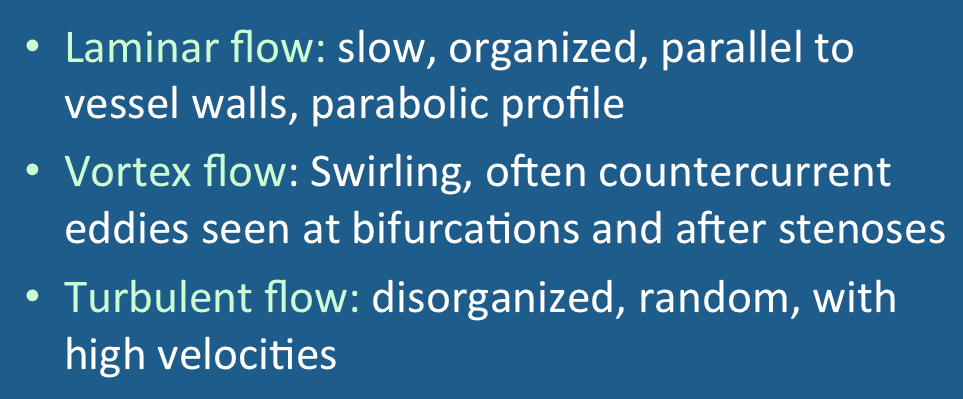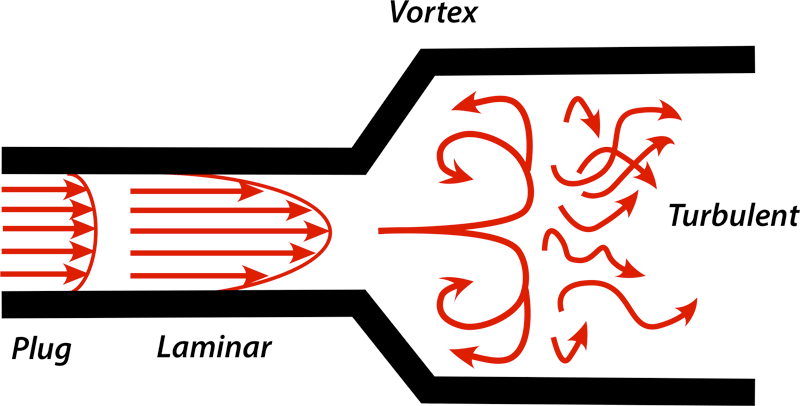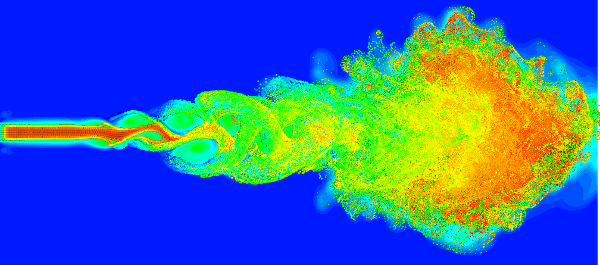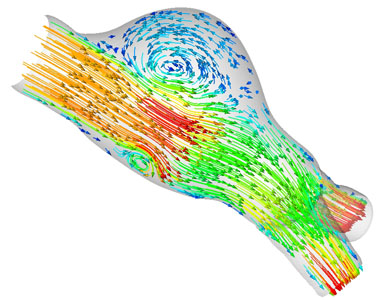|
Laminar flow refers to a predictable distribution of flow velocities in layers (lamina) that parallel the vessel wall. This form of flow is idealized but is nevertheless a fairly good approximation of the flow in medium- and small-sized blood vessels throughout the human circulatory system. Theoretically, the distribution of velocities in a perfectly straight, nonbranching vessel with nonpulsatile flow should be parabolic in cross-section, with peak velocities at the center of the lumen. In real vessels, however, the flow profile is usually more blunted because of elasticity and pulsatility effects, even though the general laminar pattern may be maintained. When the flow profile becomes flattened in this form with a nearly uniform distribution of velocities across the lumen, the term plug flow is sometimes applied.
|
|
Turbulent flow is a chaotic form of fluid transport in which velocity components randomly fluctuate. Turbulence takes place when blood velocities exceed a critical threshold or when vascular morphology creates conditions that disrupt the laminar flow state. In the human circulatory system, turbulent flow is seen in the aorta, in the region of vascular bifurcations, and distal to areas of stenosis.
In ideal fluids, turbulence can be predicted on the basis of the calculated value of a dimensionless parameter known as the Reynolds number (Re)
Re = ρ d V / η
where ρ and η are the fluid's density and viscosity, d is the diameter of the vessel, and V is the flow velocity. Values of Re less than 2000 predict that flow will be laminar, whereas values greater than 2500 usually indicate that flow will be turbulent.
|
Vortex flow refers to localized swirling or stagnant blood flow that has separated from the central streamlines within a vessel. Such vortices, also called flow eddies, frequently occur at vascular bifurcations and distal to areas of stenosis. Unlike turbulent regions, areas of vortex flow are composed of slowly moving currents and streamlines that are not random but are often countercurrent to the main flow direction. Both turbulent flow and vortex flow create problems for MR angiography.
|
Advanced Discussion (show/hide)»
No supplementary material yet. Check back soon!
References
Ku DN. Blood flow in arteries. Annu Rev Fluid Mech 1997; 29:399-434.
OpenStax College. College Physics: Laminar flow and viscosity. Rice University, 2014.
OpenStax College. College Physics: The onset of turbulence. Rice University, 2014.
Ku DN. Blood flow in arteries. Annu Rev Fluid Mech 1997; 29:399-434.
OpenStax College. College Physics: Laminar flow and viscosity. Rice University, 2014.
OpenStax College. College Physics: The onset of turbulence. Rice University, 2014.
Related Questions
How is blood flow measured in a vessel?
How is blood flow measured in a vessel?



